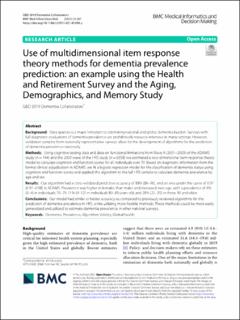| dc.contributor.author | Nichols, Emma | |
| dc.contributor.author | Abd-Allah, Foad | |
| dc.contributor.author | Hay, Simon I. | |
| dc.contributor.author | Kisa, Adnan | |
| dc.contributor.author | Murray, Christopher J L | |
| dc.contributor.author | Vos, Theo | |
| dc.contributor.author | Kisa, Sezer | |
| dc.contributor.author | Mokdad, Ali H. | |
| dc.contributor.author | Dementia Collaborators, GBD 2019 | |
| dc.date.accessioned | 2021-10-01T10:07:12Z | |
| dc.date.available | 2021-10-01T10:07:12Z | |
| dc.date.created | 2021-08-15T20:43:03Z | |
| dc.date.issued | 2021-08-11 | |
| dc.identifier.citation | BMC Medical Informatics and Decision Making. 2021, . | en_US |
| dc.identifier.issn | 1472-6947 | |
| dc.identifier.uri | https://hdl.handle.net/11250/2786943 | |
| dc.description.abstract | Background: Data sparsity is a major limitation to estimating national and global dementia burden. Surveys with full diagnostic evaluations of dementia prevalence are prohibitively resource-intensive in many settings. However, validation samples from nationally representative surveys allow for the development of algorithms for the prediction of dementia prevalence nationally. Methods: Using cognitive testing data and data on functional limitations from Wave A (2001–2003) of the ADAMS study (n=744) and the 2000 wave of the HRS study (n=6358) we estimated a two-dimensional item response theory model to calculate cognition and function scores for all individuals over 70. Based on diagnostic information from the formal clinical adjudication in ADAMS, we ft a logistic regression model for the classifcation of dementia status using cognition and function scores and applied this algorithm to the full HRS sample to calculate dementia prevalence by age and sex. Results: Our algorithm had a cross-validated predictive accuracy of 88% (86–90), and an area under the curve of 0.97 (0.97–0.98) in ADAMS. Prevalence was higher in females than males and increased over age, with a prevalence of 4% (3–4) in individuals 70–79, 11% (9–12) in individuals 80–89 years old, and 28% (22–35) in those 90 and older. Conclusions: Our model had similar or better accuracy as compared to previously reviewed algorithms for the prediction of dementia prevalence in HRS, while utilizing more fexible methods. These methods could be more easily generalized and utilized to estimate dementia prevalence in other national surveys. | en_US |
| dc.description.sponsorship | This work was funded by the Bill and Melinda Gates foundation [Grant No. OPP1152504] and Gates Ventures. | en_US |
| dc.language.iso | nob | en_US |
| dc.publisher | BMC | en_US |
| dc.relation.ispartofseries | BMC Medical Informatics and Decision Making;21, Article number: 241 (2021) | |
| dc.rights | Navngivelse 4.0 Internasjonal | * |
| dc.rights.uri | http://creativecommons.org/licenses/by/4.0/deed.no | * |
| dc.subject | Dementia | en_US |
| dc.subject | Prevalence | en_US |
| dc.subject | Algorithms | en_US |
| dc.subject | Validity | en_US |
| dc.subject | Global health | en_US |
| dc.title | Use of multidimensional item response theory methods for dementia prevalence prediction: an example using the Health and Retirement Survey and the Aging, Demographics, and Memory Study | en_US |
| dc.type | Journal article | en_US |
| dc.type | Peer reviewed | en_US |
| dc.description.version | publishedVersion | en_US |
| dc.rights.holder | © The Author(s) 2021 | en_US |
| dc.source.articlenumber | 241 | en_US |
| cristin.ispublished | true | |
| cristin.fulltext | original | |
| cristin.qualitycode | 1 | |
| dc.identifier.doi | https://doi.org/10.1186/s12911-021-01590-y | |
| dc.identifier.cristin | 1926093 | |
| dc.source.journal | BMC Medical Informatics and Decision Making | en_US |
| dc.source.volume | 21 | en_US |
| dc.source.pagenumber | 10 | en_US |
| dc.relation.project | Bill and Melinda Gates foundation: OPP1152504 | en_US |

